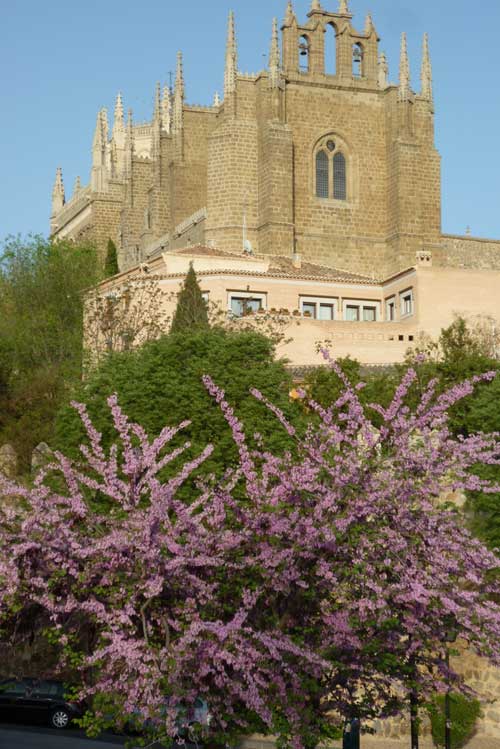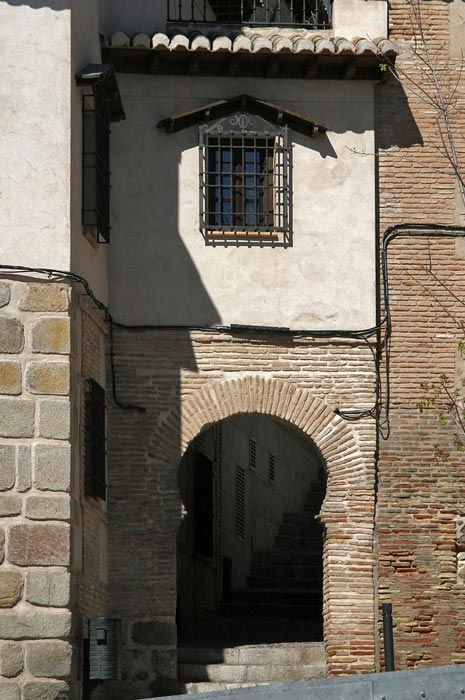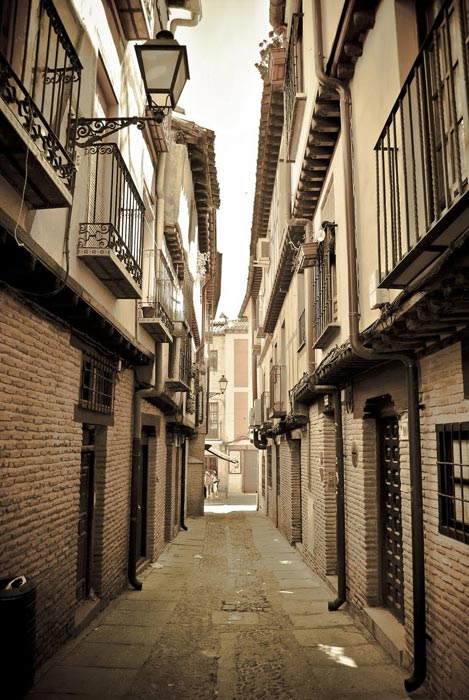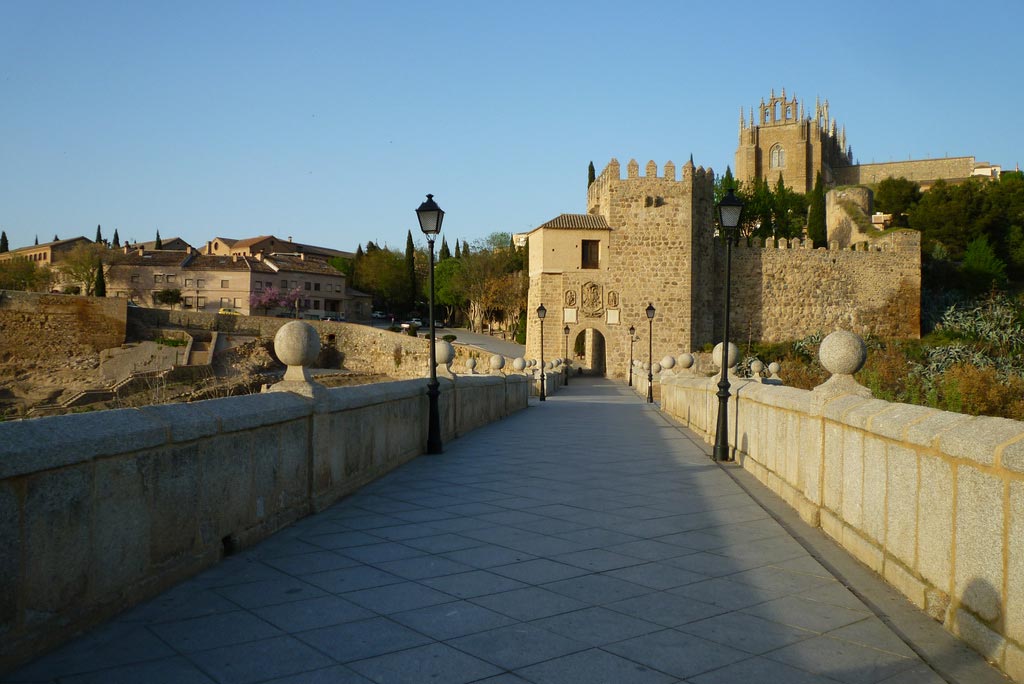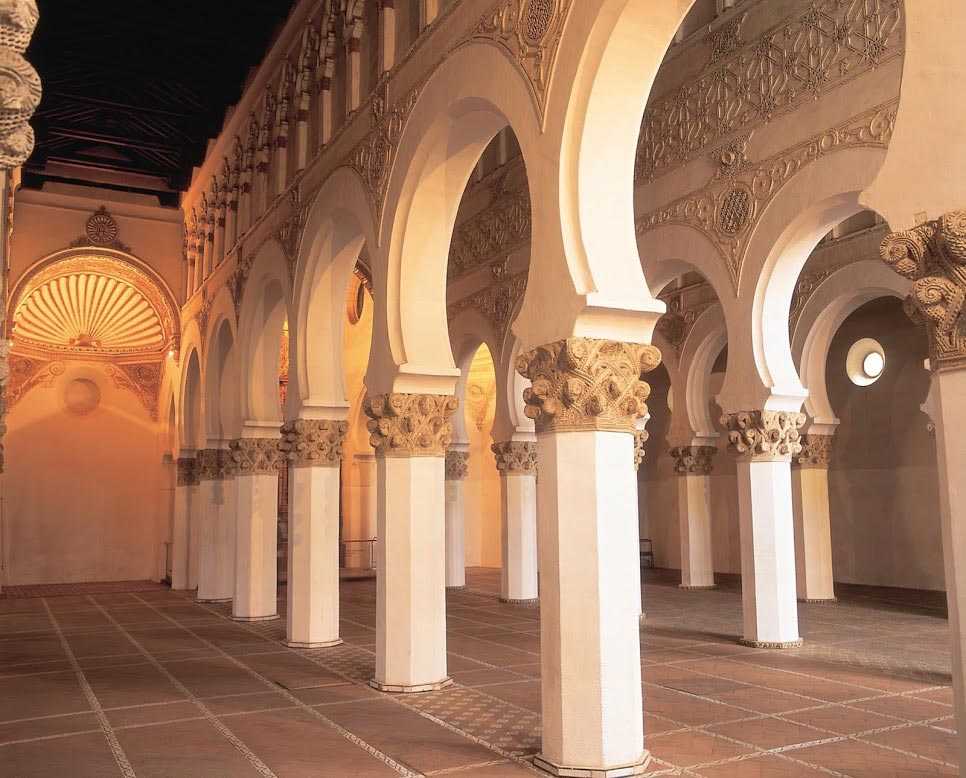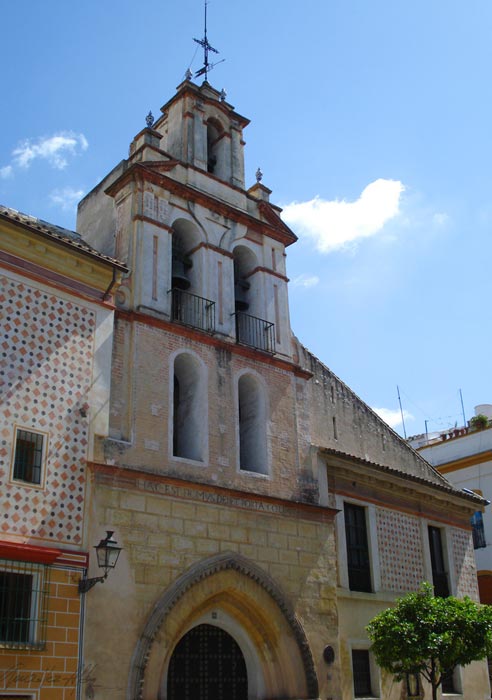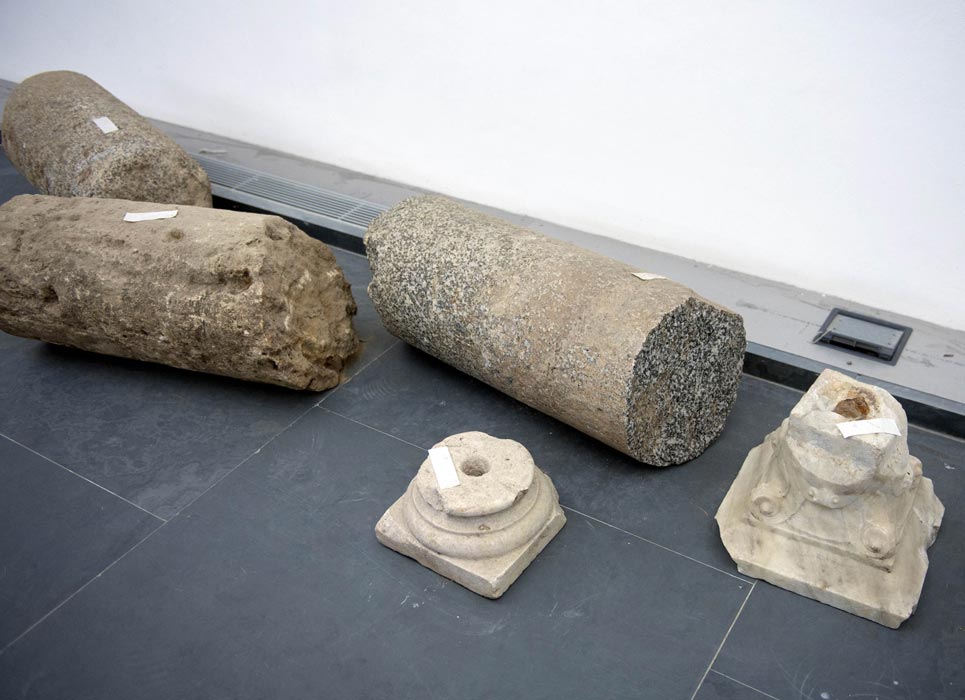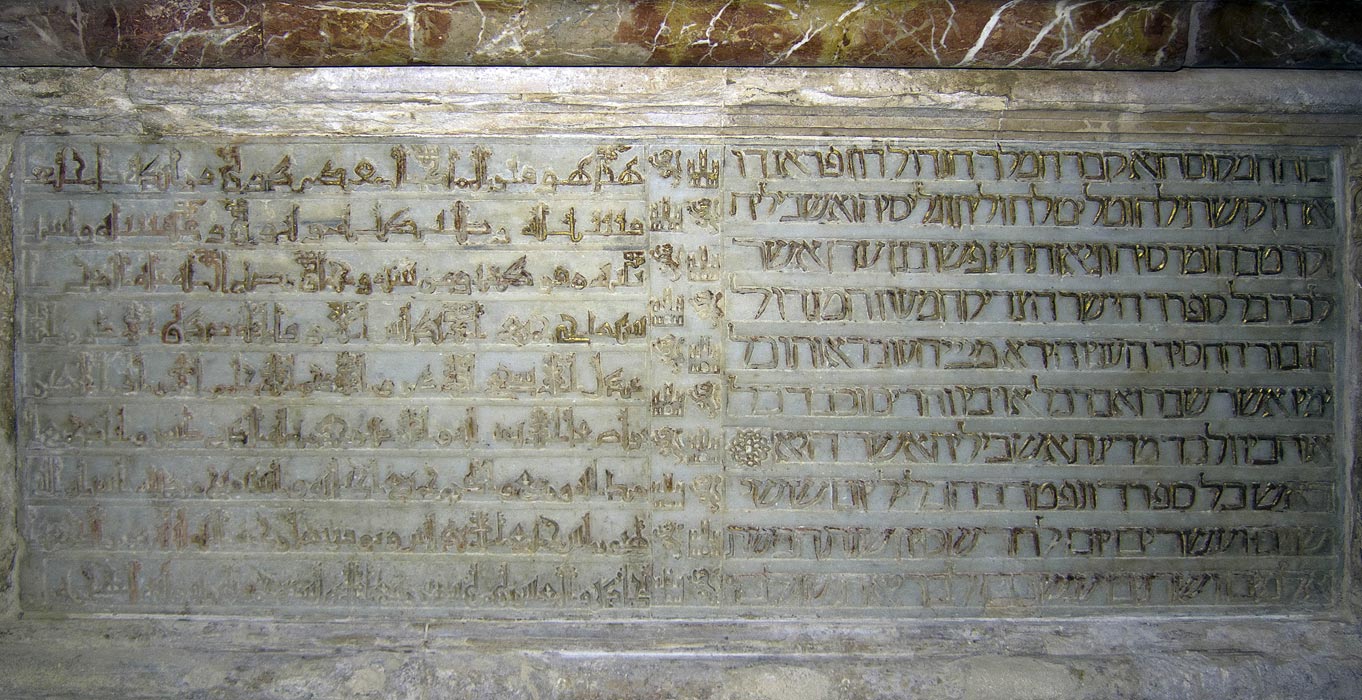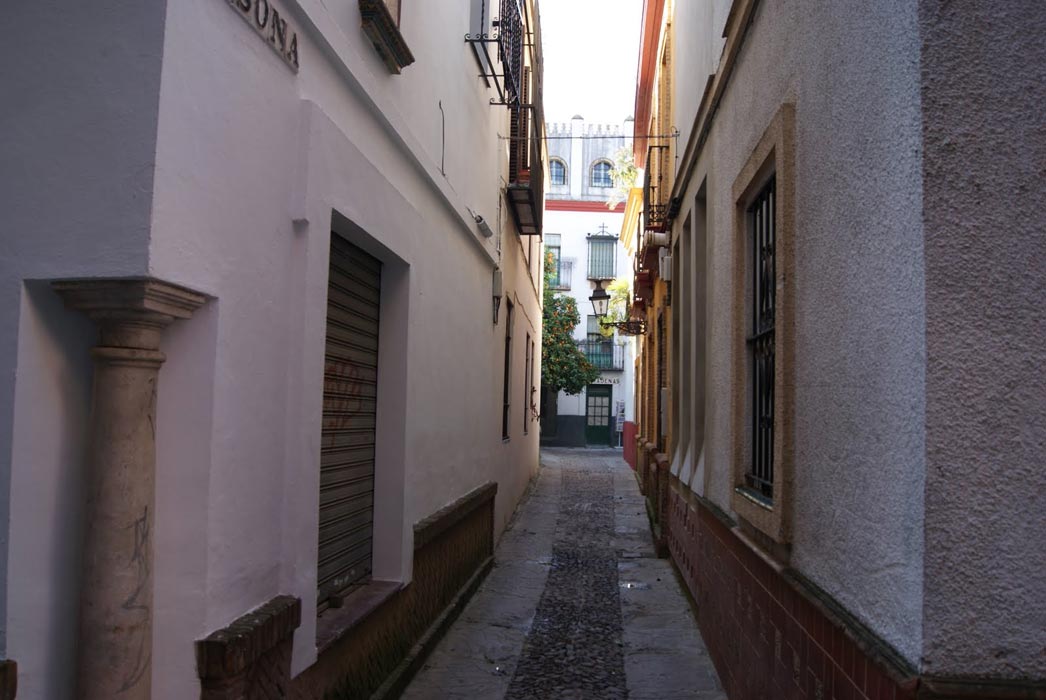The monastery of San Juan de los Reyes began to be built in 1477 by order of Queen Isabel the Catholic to commemorate her victory at the battle of Toro in 1476. Its monumental presence right in the heart of the Jewish quarter as a royal symbol for the Catholic Monarchs. The Catholic Monarchs were initially the only source of refuge for the Jewish communities before the persecutions which occurred in the late 15th century, yet they were the ones who signed the Decree of expulsion of 1492, thereby putting a permanent end to a long period of cohabitation between Jews, Moslems and Christians. The convent’s austerity contrasts with the grandiosity of the church, adorned by spacious large windows, arches and Gothic pinnacles, on whose walls the chains of the Christian convicts which had hung there since 1494 when the Catholic Monarchs recovered them after the conquest of Granada. The church was built to house the dynastic pantheon of Queen Isabel the Catholic dedicated to St.John the Evangelist. Finally, the monarchs changed their mind after the conquest of Granada, and they are buried in the Royal Chapel of the cathedral of this city. The convent was practically destroyed in the war of Independence and was only partly rebuilt, with the second cloister disappearing according to historicist criteria of the 19th century, leaving no distinction between the old and the restored one, the best example of which is the gargoyles of the cloister.
Archives: Directory listings
Directory listings
Cambrón Gate
The Cambrón Gate or Bab al-Yahud (Gate of the Jews) is the main entrance and exit of the Jewish quarter and of the city via the west. It is a highly modified gate of Muslem origin and its location coincides with the south-eastern limit of the former Jewish quarter of Toledo. The current version dates from 1576 and it was structured by repeating the Bisagra structure, in square form based on a small interior courtyard surrounded by four towers covered by slate chapters. The Cambrón Gate has fragments with Roman reliefs similar to those of the Sol gate. On both sides, there are Renaissance gateways with coats-of-arms, that of the city on the exterior and that of Felipe II on the interior. Under the latter a beautiful image of St.Leocadia can be seen, the patron saint of Toledo. The gate also bears the inscription reminding that the residents of Montes de Toledo, part of the city, are except from passage rights. Its name is associated with brambles, thorny plants which are abundant in the area.
Small Arc of the Jew – Arquillo del Judío
The Arquillo del Judio (Small Arch of the Jew) is located near the confluence of Reyes Católicos and Ángel streets where the Sofer synagogue was situated. This small arch is was passage which joined the districts of Assuica and Alacava with the main Jewish quarter via the Travesía del Arquillo, which is said to have borne witness to the sale of the jewels of Queen Isabel the Catholic to finance Colombus´ American venture. The present arch is not the original one, but was reconstructed to look like the original.
Santo Tomé District
Commercial, noisy, rife with monuments and historic, but also tourist and gastronomic references, Santo Tomé street is not only the centre of the Santo Tomé district, but also one of the main thoroughfares of the Jewish quarter. The Santo Tomé district was a well-to-do Jewish area where Christians lived too. It encompassed a large part of Santo Tomé street, the current Conde square and the first part of Alamillos and San Juan de Dios streets. In documents from the 15th century the main gate of the Jewish quarter in this district is mentioned. The church of Santo Tomé where the mythical painting by El Greco El entierro del Señor de Orgaz (The burial of the Count of Orgaz) is on display or the San Antonio convent at whose reception you can buy delicious sweets, are two major references on this street into which some alleys flow like Campana or Soledad which lend us some idea of the way in which the Jewish labyrinth was organized around the main streets of madinat al-Yahud.
San Martín Bridge
The San Martín Bridge, located in the old Jewish quarter of El Degolladero, leads to the Puerta del Cambrón, an ideal place to start the journey to the Jewish quarter of Toldeo. The bridge is alongside the waters of the Tagus, with a view of the city, providing a better understanding of the complex, difficult but fascinating history of a Jewish quarter like that of Toledo. A Jewish quarter where the keys of the houses of those who had gone into exile in 1492 had become the greatest symbol of the Sephardi nostalgia. The Jewish quarter of Degolladero largely coincided with the current Reyes Católicos street and the San Martín bridge and river. It took this name because this was the site of the Jewish butcher´s, where the poultry and cattle were slaughtered. A statue of Isabel the Catholic (1451-1504), the Queen of Castile, was located at Reyes Católicos street, very near the monastery of San Juan de los Reyes. Under the edict of expulsion of 1492 the Catholic Monarchs sent between 170,000 and 180,000 Sephardis into exile.
Santa María la Blanca Synagogue
Santa María la Blanca (“Saint Mary the White,” originally known as the Ibn Shushan Synagogue, or commonly “The Congregational Synagogue of Toledo'”) is a museum and former synagogue in Toledo, Spain. Erected in 1180, it is disputably considered the oldest synagogue building in Europe still standing. It is now owned and preserved by the Catholic Church. Its stylistic and cultural classification is unique as it was constructed under the Christian Kingdom of Castile by Islamic architects for Jewish use. It is considered a symbol of the cooperation that existed among the three cultures that populated the Iberian Peninsula during the Middle Ages.
Santa María la Blanca Church (Former Synagogue)
Santa María la Blanca Church was built in the 13th century as a synagogue, but then it was transformed into a Christian temple in 1391, after the slaughters in the Jewish quarter of Seville. In 1252, King Alfonso X, after the taking of Seville by his father, granted a synagogue to the Jews inhabiting the San Bartolomé and Santa Cruz area. The synagogue stayed until 1391, when it was converted into a Christian church. The name and dedication of Santa María de las Nieves was imposed on it by the cathedral´s chapterhouse. The side gateway, which can be accessed from Archeros street, conserves two Roman shafts crowned by several Visgoth chapters which correspond to the old synagogue. The current church of Santa María la Blanca was built in 1662 in a Baroque style, and it has a structure divided into three naves which, in turn, is split into red marble columns. The vaults are decorated in plasterwork and attributed to the Borja brothers. Murillo was probably involved in the church decoration Works and it was he who painted the midpoints, plundered by Marshal Soult during the French invasion, subsequently being replaced with copies
Santa Cruz Church (Former Synagogue)
After the slaughter in 1391 of over four thousand Jews at the hands of Sevillians driven on by the Archdeacon of Écija, there were barely any Jews left in Seville. The synagogue gradually stopped being used, and after the expulsion of the Jews from Spain ordered by the Catholic Monarchs, the synagogue was converted into a Christian church under the dedication of Santa Cruz. The architecture of this temple rested on four unequal columns. With the destruction of the temple the Church of Santa Cruz ended up setting up on Mateos Gago street and the columns were moved to the Jardín de la Aclimatación, near the Delicias gardens. This site was bought by Antonio de Orléans, the Duke of Montpensier, to annex it to the gardens of the Palace of San Telmo After the purchase in 1926 of part of the palace gardens to construct pavilions of the Iberoamerican Exhibition of 1929, La Rábida was opened and the current wall of the gardens was put up. In this way the columns were framed in the Access nearest the Chile Pavilion of the current San Telmo Gardens.
Jewish Interpretation Center of Sevilla
The Seville Jewish Quarter Visitors Centre offers visitors an exhibition about the Jews who lived in the quarter and the changes which took place from the Middle Ages up to the present day. It also talks about about the Jews who lived here and who had to abandon this land, about Jewish women and the Diaspora, and their culture, customs, songs, sayings and storytelling.
The Permanent Exhibition includes many manuscripts, some of which date from the times of the Inquisition, and the symbolic painting of the “Expulsion of the Jews from Seville”, with a number of different legends about famous figures and places of the Jewish Quarter of Seville.
Susona Street
Susone Street was previously called calle de la Muerte (death street) because of the skull of the Jewish Susona. Two tiles recall the legend on the wall of number 10 (one on each side of the corner). The first is the skull of Susona and the second recounts the legend with these words: “En estos lugares, antigua calle de la muerte, pusose la cabeza de la hermosa Suona ben Suzón, quien, por amor, a su padre traicionó y por ello atormentada dipúsolo en testamento.” It seems to be the case that the father belonged to a group of Jews which was preparing an uprising in 1481. The conspirators wanted to gain power in the city and endeavour, with the support of the Moslems, to take on the Christians of Seville. The conspiracy involved Diego Susón, banker and the ringleader; Pedro Fernández de Venedara, steward of the cathedral; Juan Fernández de Alboslaya, the attorney and Mayor, Adolfo de Triana and many more. The first of them had a daughter called Susona, who had a secret relationship with a Christian knight, whom she fell in love with. When she found that part of the plans of her father along with the other conspirators, was to kill the man she loved, she didn´t hesitate in informing him. The result was: the consouracy was disbanded and its ringleaders were arrested and sentenced to death. It is said that after her death, she asked in her will for her skull to be placed by way of punishment and example at the house where she lived of her own free will.
